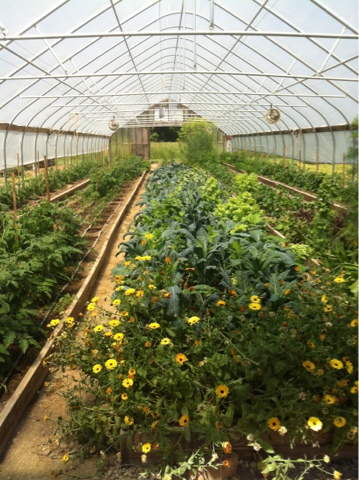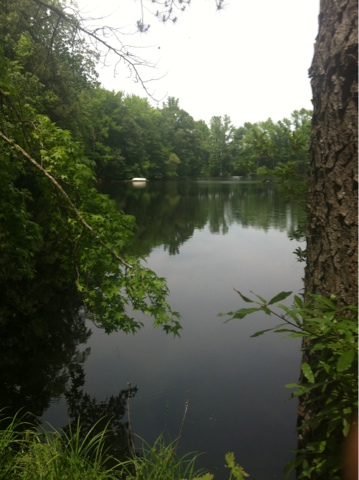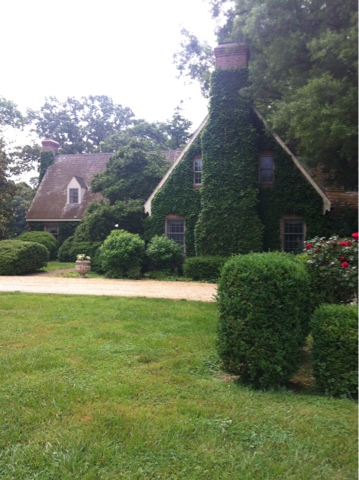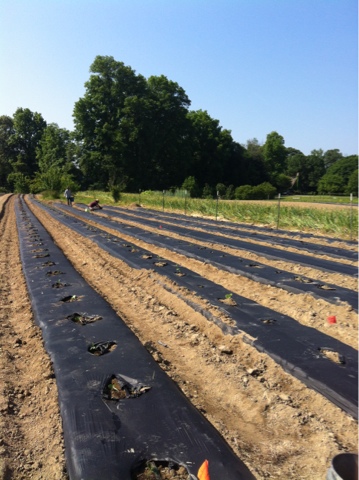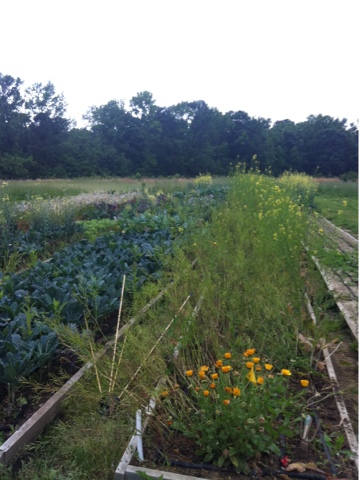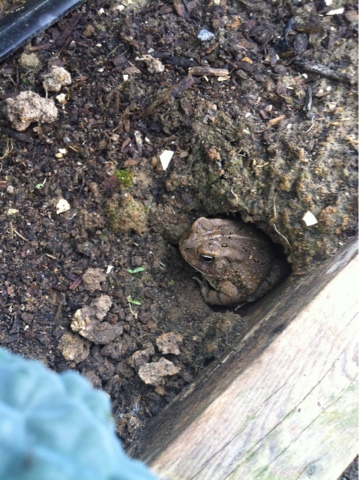My first day at Cottingham Farm began at 9:30 am on a perfect sunny day. There were enough clouds out that I was shielded by the sun part-time while working in the field planting a row of cucumbers. The temperature was mid 70's and there was a constant breeze. Deer flies would occasionally buzz around, but the breeze kept them moving. I was hot enough while working that I 1) seriously considered for the first
time that I may not be able to handle it; and 2) plotted how I would cool down. According to Cleo Braver, Cottingham Farm's visionary and owner, the creek and pond were too polluted from neighboring farms--farms that were not using organic practices. So my fantasies of midday swimming were dashed immediately; the water hose would have to do.
Cottingham Farm is a USDA certified organic farm located in Easton, Maryland on Goldsborough Creek, a tributary of the Chesapeake Bay (via the Tred Avon and Choptank rivers). Cleo, an environmental lawyer, and her husband, an environmental entrepreneur, bought the historic farm as a beautiful place to live, not for farming. For a while, they maintained the status quo: the farm already had a farm manager and he was growing corn and soybeans, which is typical for the eastern shore. In the Choptank River watershed (509,000 acres), 60% of the land is devoted to agriculture and poultry production.
This watershed represents only a small fraction of the total Chesapeake Bay watershed, which spans parts of six states: New York, Pennsylvania, West Virginia, Maryland, Delaware, Virginia plus Washington DC. It is the third largest estuary in the world with over 100,000 rivers and streams, filtering and protecting the drinking water of 75% of Bay watershed residents through its forests and trees. Most of us already know that it's future is gravely threatened by pollution, but probably like me, don't really fully grasp how and why this happens. According to the Chesapeake Bay Foundation's website, pollutants to the Bay come from 4 major sources: urban and suburban runoff (16%), waste water treatment and factories (19%), Air pollution (27%) and agricultural runoff (38%).
Cleo began asking her farm manager tough questions about her farm's practices. It was not long before she realized that her farm manager had no intention of implementing her requested best practices to protect the watershed. Chief among them was to take 50 acres out of production, about 20% of their tillable land, for the creation of buffer zones and a wetland.
It was at that point that Cleo realized that she wanted to redirect the farm entirely for organic vegetable production. Maryland has 2,050,000 acres of farmland. Of that, only 7,100 are farmed organically. While there may be twice that practicing organic growing without the certification, the amount of acreage USDA certified is not statistically significant in Maryland. Cleo is a pioneer, and her commitment to organic growing and watershed sensitive farming is all the more significant because her farm is a part of the Chesapeake Bay watershed. Environmentally sensitive farming is hard anywhere. To do it in an area where it must be done in one of the greatest watersheds of the world is an incredibly complex business. As the polluted stream and pond on this farm are illustrate.
While it seems hard to believe, Maryland's eastern shore, potential breadbasket to 3 urban areas of significant size, would appear to be woefully behind in its production of chemical free food. When I asked Cleo about the depth of the market for organic vegetables, she answered, "endless".
Now, 4 or 5 years later, Cottingham Farm has developed a small CSA membership, a high end restaurant clientele-including my favorite,-Woodberry Kitchen, and sells wholesale to Whole Fields. The primary crop is heirloom tomatoes, but there are a great many more vegetables grown on the farm.
In this blog, I'll explore the interrelationship of agriculture and the environment through the lens of food farming and Maryland's eastern shore. I'm fascinated by Cleo's vision, one that sees Maryland's eastern shore taking its rightful place as providing healthy and environmentally produced, locally grown food for Baltimore and Washington DC. Cleo explained to me that the market size should decrease, not increase. The idea is to localize, deeply localize food production.
So, on .008% of the farmland in Maryland, my education on my own home state begins from a completely new perspective: agriculture. Can this region, through organic and humane animal food production, become more diversified and economically vibrant while positively impacting the Chesapeake Bay?
